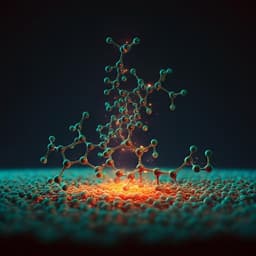
Engineering and Technology
An Eco-Benign Biomimetic Approach for the Synthesis of Ni/ZnO Nanocomposite: Photocatalytic and Antioxidant Activities
M. Alhar, D. Muhammad, et al.
Discover a groundbreaking green synthesis method for Ni/ZnO nanocomposite, revealed through an array of sophisticated techniques. This innovative material not only showcases impressive antibacterial properties against common pathogens but also excels in antioxidant and photocatalytic activities. Join researchers M.SO Alhar, D Muhammad, K Tahir, and their team in exploring its potential for biological applications and environmental remediation.
~3 min • Beginner • English
Introduction
Industrial discharge of toxic dyes compromises water quality and poses risks to ecosystems and human health. Metal oxide nanomaterials, particularly ZnO, offer promising photocatalytic and antibacterial performance due to tunable physicochemical properties (shape, size, crystallinity, porosity). ZnO is widely applied in catalysis, sensing, drug delivery, and antimicrobial uses and is known to inhibit pathogens such as P. aeruginosa, S. aureus, B. subtilis, and E. coli. Doping or decorating ZnO with metals can enhance photocatalytic efficiency by improving light absorption and suppressing electron–hole recombination. Hybrid nanomaterials composed of multiple functional components can outperform their individual constituents. Prior studies (e.g., NiFe2O4/ZnO) reported enhanced photocatalytic and antibacterial activity compared with pure ZnO. Building on this, the present work synthesizes Ni-decorated ZnO (Ni/ZnO) nanocomposites via ammonia evaporation and co-precipitation, targeting improved photocatalytic degradation of methylene blue (MB) and potent light-activated antibacterial activity.
Literature Review
The study references extensive literature on ZnO’s multifunctionality and antimicrobial properties, the environmental impact of dye pollutants, and the advantages of metal-doped and hybrid ZnO systems for photocatalysis and antibacterial action. Prior reports show doped ZnO exhibits higher photocatalytic activity than pristine ZnO by reducing charge carrier recombination. Hybrid composites (e.g., NiFe2O4/ZnO) have demonstrated synergistic improvements in dye degradation and bacterial inhibition. The work also situates its approach among green/biomimetic syntheses that yield stable, active heterojunctions or metal-decorated ZnO for environmental remediation and biomedical applications.
Methodology
Synthesis of ZnO: 1.148 g ZnSO4·7H2O was dispersed in 40 mL distilled water and sonicated 10 min. Separately, 0.48 g NaOH was dissolved in 30 mL water and added dropwise under continuous stirring to form Zn(OH)2. The precipitate was filtered (Whatman), washed three times with double-distilled water and twice with ethanol, dried at 60 °C (microwave oven) for 6 h, then calcined at 400 °C for 4 h to obtain ZnO.
Post-synthesis of Ni/ZnO nanocomposite: 0.1 g Ni(acac)2 was dissolved in 20 mL distilled water and sonicated 10–15 min. Separately, 2 g synthesized ZnO was dispersed in 80 mL water. The nickel solution was added dropwise into the ZnO dispersion under stirring; 30% ammonia solution was used to maintain basic pH, stirring continued for 2 h until light-green color formed. The product was centrifuged (3000 rpm, 10 min), washed with distilled water, and dried at 60 °C for 24 h.
Characterization: UV–Vis absorption spectroscopy monitored formation and optical properties; XRD assessed crystallinity and phase; FT-IR identified functional groups; HRTEM determined morphology and particle size; SEM visualized surface morphology; EDX confirmed elemental composition; XPS analyzed surface chemistry (mentioned among techniques). Crystallite size was estimated via Scherrer equation using Cu Kα (λ = 0.154 nm).
Photocatalytic activity test: MB was used as a model pollutant. 4 mg Ni/ZnO was added to 25 mL MB solution, stirred 35 min to reach adsorption–desorption equilibrium, then irradiated under visible light (300 W xenon lamp, 420 nm cut-off filter) with continuous stirring. At intervals, 3 mL aliquots were withdrawn, centrifuged to remove catalyst, and MB absorbance recorded (Shimadzu 2450). Parameter studies included catalyst dosage (0.6–11 mg in 80 mL of 16 mg/L MB, 300 V visible bulb, 5 min irradiation), initial dye concentration (9–36 mg/L; 30 mg Ni/ZnO in 80 mL, 5 min irradiation), pH effect (pH 4–11 adjusted with HCl/NaOH; 9 mg/L MB, 60 min irradiation), and scavenger tests (10 mg Ni/ZnO with MB 2 mM in presence of benzoquinone, ethanol, or sodium oxalate to probe O2•−, •OH, and h+).
Antibacterial activity: Agar well diffusion against E. coli, S. aureus, and P. aeruginosa. Bacteria grown at 37 °C, spread on nutrient agar; 6 mm wells loaded with 50 µL of 1 mg/mL Ni/ZnO in DDW. Plates were exposed to visible light for 80 min and then incubated 18–20 h at 37 °C. Zones of inhibition measured under light and dark conditions. Degradation turnover (dTON) was calculated as dTON = ([Mi] − [Mf])/(t × [Cat.]) with Mi and Mf the initial and final bacterial concentrations (mmol or µmol), t time (h), and [Cat.] catalyst mass (g).
ROS determination: E. coli incubated with Ni/ZnO for 3 h at 300 rpm; cells then treated with 2,7-dichlorodihydrofluorescein diacetate (DCFH-DA, 15 mM) for 60 min, washed with PBS, and fluorescence measured (excitation/emission around 488 nm) to indicate intracellular ROS.
Minimum inhibitory concentration (MIC): Agar well dilution with Ni/ZnO concentrations 20–70 µg/mL; 1 mL nanocomposite solution mixed with 1 mL bacterial suspension, incubated at 37 °C for 20 h; conducted in triplicate.
Hemolytic activity: Mouse RBCs were incubated with Ni/ZnO at 12.5–125 µg in PBS (1 mL total volume). Negative control: RBCs in PBS; positive control: 1% Triton X-100. After 1 h at 37 °C on shaker, samples were centrifuged (10 min; reported 15 rpm in text) and absorbance of supernatant measured at 540 nm to quantify hemolysis.
Antioxidant activity: DPPH assay with Ni/ZnO in methanol at 0.031–1 mg/mL mixed with 0.5 mL of 1 mM DPPH; incubated in dark 30 min. Ascorbic acid used as reference. Absorbance at 517 nm recorded and Percent Inhibition = (A − B1)/A × 100 computed, where A = control absorbance and B1 = sample.
Key Findings
- Optical properties: UV–Vis absorption showed Ni/ZnO peak around 305 nm; during synthesis, peaks at ~322 nm (ZnO) and ~534 nm (Ni) increased over time up to 80 min, indicating nanocomposite formation.
- XRD: Ni nanoparticles showed fcc peaks at 44.2° and 53.7°. Ni/ZnO showed ZnO wurtzite peaks at approximately 31.9°, 34.8°, 36.4°, 47.5°, 56.6°, 63.1°, 67.0°, 68.2°, and 69.2° indexed to (100), (002), (101), (102), (110), (103), (112), (200), (201) (JCPDS 36-1451), plus Ni metal peaks at 44.5° and 51.7° ((111) and (200), JCPDS 04-0850). Scherrer crystallite size ~21 nm.
- FT-IR: Peaks at 3401 cm−1 (O–H stretch), 1544 cm−1 (O–H bend), 992 cm−1 (Ni–O–Ni), 874 cm−1 (Zn–O–Zn), 544 cm−1 (N=O), and 478 cm−1 (Zn–O).
- HRTEM: Pristine Ni showed aggregation with average size >30 nm; in Ni/ZnO, Ni particles were uniformly dispersed on ZnO with average size ~13 nm; spherical morphology and good dispersion observed.
- SEM/EDX: ZnO appeared as porous sheets; Ni nanoparticles were highly distributed as spherical particles over ZnO’s rough surface. EDX confirmed Ni, Zn, and O elements, evidencing Ni coating on ZnO.
- Photocatalysis of methylene blue (MB): Under visible light, Ni/ZnO achieved 100% MB degradation in 60 min; pure ZnO showed lower activity. Catalyst dosage study (80 mL, 16 mg/L MB, 5 min irradiation) showed increasing degradation with 0.6–9 mg Ni/ZnO (46%, 60%, 71%, 80%, 89%, 100%), then decreased at 11 mg (88%) due to light scattering/turbidity. Initial dye concentration test (9–36 mg/L; 5 min) yielded 97% (lowest concentration), then 88%, 58%, and 47% at higher concentrations. pH effect (60 min, 9 mg/L MB): degradation increased from pH 4 to 10 (60%, 70%, 80%, 100%) and slightly decreased at pH 11 (96%). Scavenger studies indicated O2•− and •OH radicals (benzoquinone and ethanol effects) are dominant reactive species, with h+ less influential (sodium oxalate minimal effect).
- Antibacterial activity (zones of inhibition, mm): Irradiated Ni/ZnO: E. coli 16 ± 0.3; P. aeruginosa 19 ± 0.4; S. aureus 23 ± 0.5. Dark Ni/ZnO: E. coli 8 ± 0.4; P. aeruginosa 10 ± 0.4; S. aureus 14 ± 0.5. For comparison, Ni alone: 11 ± 0.4 (E. coli), 9 ± 0.3 (P. aeruginosa), 9 ± 0.2 (S. aureus); ZnO alone: 13 ± 0.3, 14 ± 0.4, 5 ± 0.3, respectively. dTON values (µmol h−1 g−1): irradiated Ni/ZnO 413; dark Ni/ZnO 392; ZnO 311; Ni 298.
- MIC: Ni/ZnO MICs were 30 µg/mL for E. coli and P. aeruginosa; 20 µg/mL for S. aureus.
- ROS generation: DCFH-DA assay showed green fluorescence in bacterial cells treated with Ni/ZnO under light, indicating intracellular ROS. SEM showed significant morphological damage to E. coli after Ni/ZnO treatment under light.
- Hemolysis: Ni/ZnO exhibited negligible hemolytic activity across 12.5–125 µg, comparable to PBS control; 1% Triton X-100 positive control caused ~99.9% hemolysis, indicating good hemocompatibility.
- Antioxidant activity: DPPH radical scavenging increased with concentration, reaching up to ~82% inhibition at 1 mg/mL, indicating moderate antioxidant capacity.
Discussion
Decorating ZnO with Ni improved light absorption, created additional active sites, and facilitated charge separation, thereby reducing electron–hole recombination and enhancing photocatalytic degradation of MB. Optimizing catalyst dosage (9 mg/80 mL) and pH (alkaline, pH 10) maximized performance, while higher dye concentrations or excessive catalyst loadings reduced efficiency due to active site coverage and light attenuation. Scavenger tests confirmed O2•− and •OH as primary reactive species driving MB degradation. The Ni/ZnO nanocomposite also exhibited superior antibacterial activity under visible light relative to dark conditions and to individual Ni or ZnO, attributable to ROS generation leading to oxidative stress, membrane damage, and bacterial cell death, as supported by fluorescence and SEM analyses. The material’s negligible hemolytic activity suggests acceptable compatibility with red blood cells, and its DPPH scavenging indicates moderate antioxidant behavior, potentially aiding biological applications. Overall, Ni decoration synergistically enhances ZnO’s photocatalytic and antimicrobial functions via morphology control, increased surface area, and improved charge carrier dynamics.
Conclusion
A facile, eco-benign synthesis yielded Ni/ZnO nanocomposites with high crystallinity, controlled nanoscale morphology, and uniform Ni dispersion on ZnO. The material showed excellent visible-light photocatalytic degradation of MB (up to 100% under optimized conditions), potent light-induced antibacterial activity against E. coli, P. aeruginosa, and S. aureus with favorable MICs, negligible hemolytic effects, and moderate DPPH radical scavenging. These results position Ni/ZnO as a promising candidate for environmental remediation and bio-related applications, with the study opening perspectives for designing multifunctional nanomaterials leveraging ROS-mediated mechanisms.
Limitations
Related Publications
Explore these studies to deepen your understanding of the subject.







